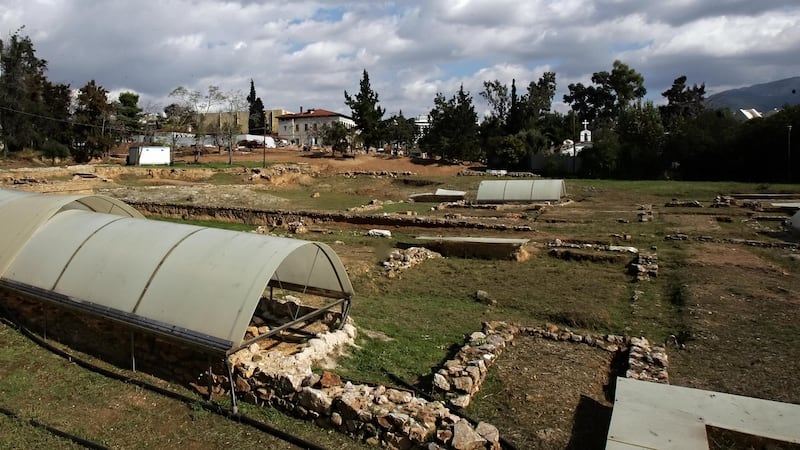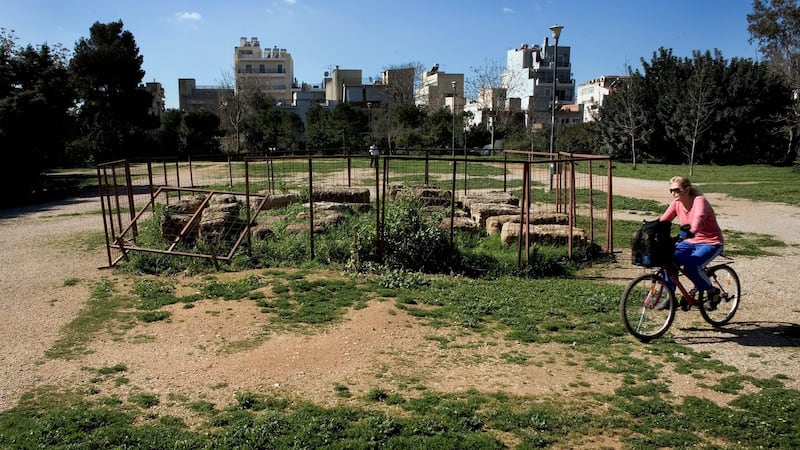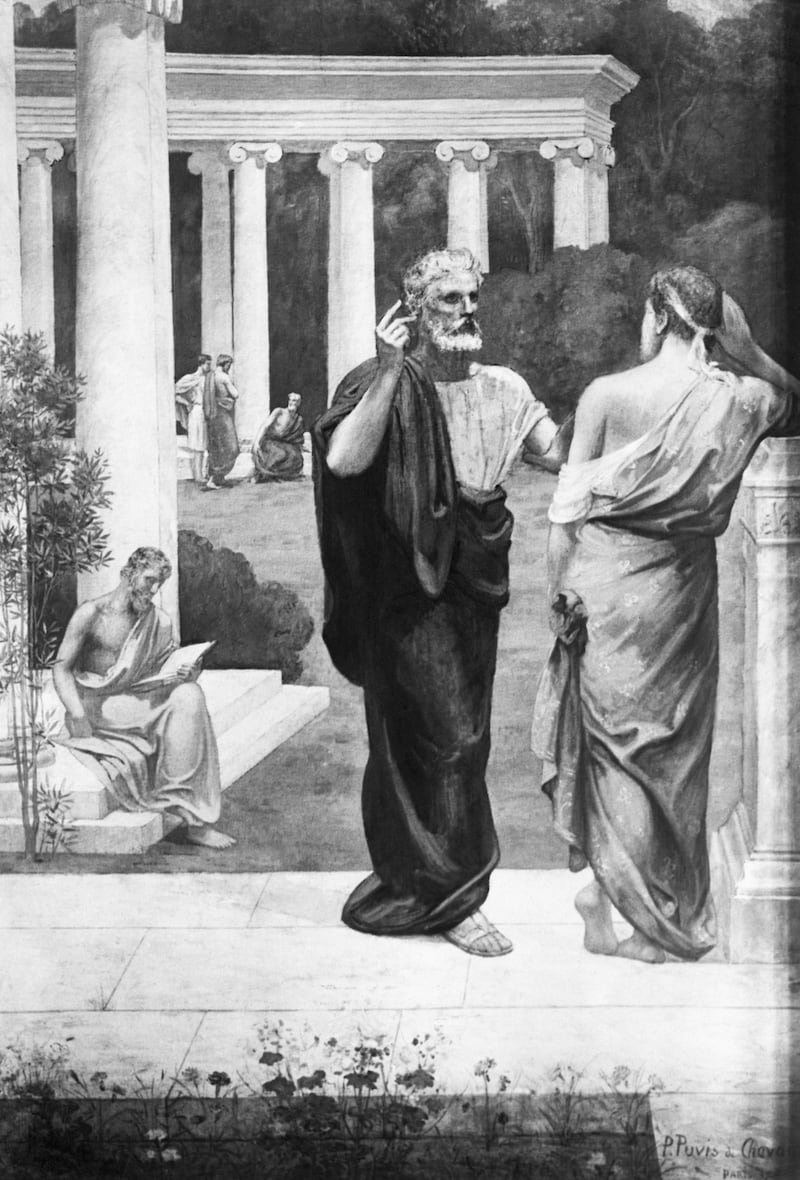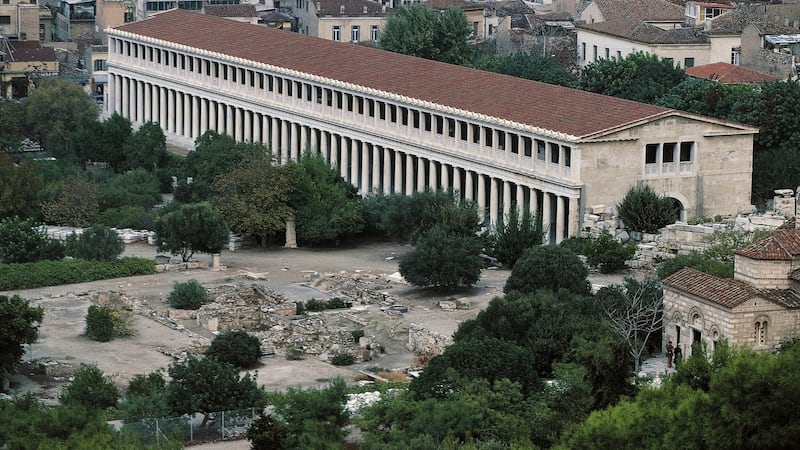It is as it should be. For Aristotle reality resided in the materiality of visible things and his school, the Lyceum, now finds itself in Kolonáki, downtown Athens’ premier residential neighbourhood, bang in the centre of the city.
For Plato reality resided in distant and invisible ideas and his school, his Academy, has ended up in Kolonós, an out-of-the-way neighbourhood on the way to Piraeus and at the opposite end of the desirability scale from Kolonáki.


To the untrained eye the Lyceum today is little more than collapsed walls and holes in the ground, but it is in good company: next to the Athens Conservatoire on King Constantine Avenue, behind the imposing Officers’ Club on Queen Sophia Avenue, and around the corner from the Turkish embassy. So it is protected at all times by a large posse of well built and well armed riot police.
Plato’s Academy, on the other hand, is by far the more evocative of the two sites, in a charming and peaceful urban park, but it is surrounded by ugly blocks of flats and abandoned shops, and is seldom visited by anyone, except for locals walking their dogs. And to add insult to injury it now abuts the proposed location for a huge shopping mall and attendant parking lots. However Plato’s would-be heirs have said – enough!
On a wonderfully balmy Sunday in early November, which made even Kolonós look attractive, we joined about 50 members of the area’s local history society – named after Plato’s Academy – on a two-hour walk from there to the ancient agora at the foot of the Acropolis, through some of Athens’ least attractive suburbs.
As far as possible we followed the route of the so-called dimósio síma (public cemetery), the road leading from Athens to Piraeus along which the tombs of prominent Athenians were erected in ancient times – no such thing as going quietly in those days! – and every four years the torch procession to mark the opening of the Panathenaic Games took place.
There was not much to see, in truth, apart from plaques indicating the location of sites we might have seen if they hadn’t been built over and the occasional wrapped-up archaeological dig in a vacant lot next to a towering modern building. But there is something exciting about walking through a “forbidden city”, smug in the knowledge that you are reaching parts which no other tourists can reach. And in any case seeing things was not the only purpose of the exercise.
The walk was part guided tour, part pilgrimage and part civil rights march. Even as it sought to enlighten the residents of Kolonós on the glorious past of a city which was also theirs and not just the residents’ of Kolonáki and whose sacred heart, the ancient agora (the birthplace of democracy?), beat for all and not just some Athenians, it aimed to draw attention to the degradation which their neighbourhood had been allowed to endure and was in danger of enduring forever more, with the construction of that monstrous mall.
But now, with Plato on their side, they were fighting back. Was Plato not as worthy as Aristotle? Was he not in fact Aristotle’s master? So why should the Academy not deserve the same respect as the Lyceum? They therefore request that the authorities make every effort to draw tourists to their neighbourhood as well and to ensure the heart of the city officially comprises Kolonós too. They want the dimósio síma to become truly dimósio so that the celebration of Athens can be properly Panathenaic.
Towards the end of the walk, as we approached the area of Keramikós, the ancient potters’ quarter, with its proper archaeological site (of the kind that deserves pride of place in a tourist guide), we passed along streets lined with beautiful neo-classical buildings, built in the 19th century, when Athens had just become the capital city of a newly independent state.

Some of the buildings looked abandoned and were in a sad state of repair, but others were in perfect condition and looked stunning. We had no time to pause and admire them however. Our guide had eyes only for what was ancient and, bearing his own (metaphorical) torch to shed light only on what was deemed by him to be noteworthy, he drove us on relentlessly towards the agora.
Perhaps, like some of his fellow countrymen, he found it difficult to be unambiguously proud of Greece’s more recent past. The struggle for independence had got rid of the Turks, but had it delivered true freedom and democracy? There had been dictatorships, class conflicts and a civil war, and now there was the Crisis. Antiquity was a safer place to be, especially if one could fashion it in the image of one’s dreams and aspirations.
But taking refuge in the past is not an option for everyone. Certainly not for the young people who handed out leaflets to us as we oohed and aahed before the ruins of Keramikós. My social profiling skills told me they must be anarchists. Both dressed in black, he tall and handsome with the regulation beard and a scowl on his face, she short and plump, with orange hair, rings in her nose and ears, and a cigarette between her lips. However, the larger of the leaflets, written in Greek, had a picture of three Stars of David, each with a name on it – Richard Guttfried, Rose Mallinger, Barry Rabinowitz – and a title which read: “Do you remember the one which starts with a joke about Soros and ends with bullets?”, followed by two dense pages of text on the resurgence of antisemitism. The smaller leaflet, written in English, simply said, in big capital letters: “ANTISEMITISM IS THE LANGUAGE OF FASCISM.”
It was a few days after the murderous attack on the synagogue in Pittsburgh and we were around the corner from Athens’ two synagogues, one on either side of an attractive street we had just walked through, and both guarded and fortified as though they were in a war zone. Our guide had not shone his torch on those either.
Ancient Athens was the order of the day, after all, and the agora our destination. So we marched on, ignoring the young people and trampling under foot many of the small leaflets which their recipients had discarded and which lay like a carpet on the last stretch of the dimósio síma. And as we proceeded I overheard a kindly looking couple from among our fellow pilgrims, dressed in their Sunday best, working themselves up about “those people … all that money … controlling the banks …” Oh Lord, I said to myself, please don’t let me hear this, not on a beautiful day like today. And I made a headlong dash for the agora.
* * *
The agora is the past at its best, providing instant gratification to selfie-seeking tourists, who had come in droves on that day even though it was late in the season: evocative ruins amidst ancient olive trees, a classical temple better preserved than the Parthenon, a picturesque Byzantine church, winding paths, secret groves, sun-seeking tortoises, venerable cypresses, flowering bushes, a row of restored neo-classical buildings in the distance, higher up the resplendent Acropolis, and higher still a deep-blue cloudless sky.
And to think it could all have been so very different – if the authorities had not decided to relocate the refugees who had settled there after the 1922 Catastrophe of Smyrna, when Turkey expelled and massacred the population of what for centuries had been a Greek (and Armenian, and Jewish) city on the coast of Asia Minor, now Ismir! Just imagine! A refugee camp instead of the agora!
How can we not be grateful to the authorities for their discriminating sense of the past? For the agora, surely, is our past too. The picturesque and glorious past bequeathed to us so lovingly by Grand Tourists and Philhellenes.
Lest that past be taken away from us again, in the 1950s American archaeologists, with the support of the Rockefeller Foundation, decided to set it in concrete, so to speak, by rebuilding, in a corner of the agora, the second-century BC Stoa of Attalos. We should not be surprised, I suppose, that the initiative came from the States, given that country’s shaky hold on history and given that a stoa is, in a sense, the ancient precursor of a shopping mall.
Nowadays archaeologists would no longer dare to be so blatant in their reconstruction of the past and purists claim that the Stoa of Attalos as it now stands is out of character with the way it once was, but tourists certainly like it. It panders perfectly to their need for a quick-fix grasp of the way things were, and from its first floor it offers enchanting vistas of the agora and perfect angles for photographs and selfies. But on that day what caught my eye was what you saw when you looked the other way.
Against the back wall of the first-floor portico of the Stoa there stood a photographic exhibition, made up of 39 panels celebrating the European Heritage Label. The what? – you may be tempted to ask. I certainly was.

“The European Heritage Label,” Tibor Navracsics, the EU Commissioner for Education, Culture, Youth and Sport explains on the introductory panel, “recognises sites which have played a significant role in the history, culture and development of the European Union and highlight their European dimension through information and educational activities. Thirty-eight sites have received the European Heritage Label since 2013. I warmly invite you to discover these sites and see how some of them showcase our road to unity or our struggle for peace, while others symbolise our quest for knowledge or were at the forefront of creating our historical legacies. All of them have a crucial place on our shared path to freedom and democracy.”
That’s a pretty tall order for so few labels, I said to myself and, growing ever more intrigued, I decided to take up Navracsics’s invitation.
No explanations are given as to how the labels are chosen and produced or by whom, but I suspect it must be the work of a committee, and possibly a committee more used to dealing with the rights and welfare of consumers. Labelling the past is like putting it in jars, listing the ingredients and telling you whether or not it is good for you. In this case, the committee was in no doubt whatsoever. It was all 100 per cent Good-For and might just as well have been displayed on the shelves of an organic supermarket rather than in an archaeological museum, although admittedly one does at times need the skills of an epigraphist to make sense of it.
On that particular Sunday, however, not many people could be bothered. They had come for the picturesque and sun-drenched past on the other side and looked at me goggle-eyed when they saw me taking notes. “One of those vegans,” they must have thought, “using pen and paper … can you believe it?” And no doubt they wondered why on earth I wasn’t looking it up on the internet or storing it for future reference in my iPhone. And they would have been right. I don’t own a smartphone and in that respect I am most definitely a creature of the past.
Not like that elderly Japanese couple next to me – so elegant and distinguished, they looked like the emperor and empress – who were taking endless selfies on the iPad the husband bore valiantly aloft on a selfie-stick, waiting patiently for other tourists to get out of the way and alternating, apparently at random, between European labels and statues of naked youths and goddesses. They certainly had not been left behind by passing time. They knew all too well how to collect the past in the age of the fleeting present.
It could be, of course, that they had done their homework before coming and had checked the internet. There they would have seen that the homepage of the European Heritage Label sports a beautiful picture of the Parthenon, overwritten with the words “EUROPE STARTS HERE!” So perhaps they were simply gathering evidence to mull over back home in order to solve the mystery.
To discover the secret, that is, of Europe’s ageless Beauty, the link between Athena, Attalos and Schengen! If only they had asked me, I could have told them. I had read all the Labels and sussed out all the ingredients. And this is what I’d learnt.
* * *
The History of Europe in Thirty-Eight Labels as Devised by a Committee and Decoded by a Curious Bystander:
The countries that have done most for Europe are Poland and the Netherlands, which each have four Labels. Next come France and Germany, which have three and a half each, one being shared between the two of them in the name of entente cordiale. Hungary and Portugal have three, Estonia, Slovenia, Austria, Italy and Spain two, and Lithuania, Croatia, the Czech Republic, Romania, Belgium, Luxembourg and Greece only one. The UK has none, of course, since it was too busy brexiting before it even started to brenter. But neither have Bulgaria, Cyprus, Denmark, Finland, Ireland, Latvia, Malta, Slovakia and Sweden. Someone must have gone to sleep on the job. Or perhaps the committee is waiting for the public to make submissions?
The official languages of Europe are English (of a sort) and Greek, and possibly also Hungarian, since the Commissioner in charge is Hungarian.
Europe has two fathers, Robert Schuman, who sounds German but is French, and Alcide De Gasperi, who sounds French but is Italian (Labels 32 and 34). It has no known mother, but the first Europeans, contrary to what the homepage suggests, were the Neanderthals, who lived in Croatia about 125,000 years ago (Label 1). Subsequently the Neanderthals became extinct, which probably explains why Europe is in a bit of a mess right now, but hopefully when Homo Sapiens catches up with it, things will get better.
After the Neanderthals came the Greeks who, from the heart of ancient Athens, gave us such things as democracy, logic and equal rights (Label 2). However, they forgot to tell their women. But all things told, that is probably just as well, since women are notably devoid of logic and might have insisted, had they been told, on becoming democratic themselves. The Greeks also forgot to tell the slaves, but that is also for the best, since democracy needs an underclass to sustain the equality of opportunity myth on which it is founded.
Aside from the Greeks, nobody has done quite as much for democracy as the Poles (Labels 12, 14, 35), although there too there appears to have been a breakdown in communications. Their government, it would seem, was not informed.
After the Greeks came the Romans, but they were not very important, because they were in Austria and not in Rome (Label 3). Then the Europeans became Christian, thanks to the French (Label 4) and the Czechs (Label 6).
Jews on the other hand only arrived much later, in the middle of the 19th century, when the largest synagogue in Europe was built in Budapest, to which was then added “a garden used as a cemetery for the victims of the Holocaust […]a symbol of integration, remembrance and openness to dialogue” (Label 17). This means that those people who make such a fuss about the Holocaust do not know what they’re talking about. The Jews did not simply disappear. Their remains were lovingly gathered up by the SS and buried in a lovely garden in Budapest.
Once the Europeans had become Christian, they decided the rest of the world needed discovering. So in 15th-century Portugal they devised “projects of maritime expansion” which “set European civilisation on its path to the global projection that came to define the modern world” (9). Some people call that colonialism, but they are wrong. The aim of “global projection” was simply to introduce the discovered natives to the “modern world”, for which they have ever since been exceedingly grateful.
Global projection of course could not have happened without imperialism, which was invented in Austria and is why we celebrate Vienna’s imperial palace (Label 11). Plans are currently afoot to bring back the Habsburgs, the Hohenzollerns and Napoleon, while Europeans count themselves privileged to have been allowed to hold on to the Windsors, the Bourbons and the Oranges.
Meanwhile the Europeans also became capitalists, which happened in Estonia (Label 8). As a result they most definitely do not like communism (Labels 26 and 30) and there was a festival in Germany to celebrate the demise of political repression (Label 16). They do, however, like music, which was invented in Germany and in Hungary (Labels 5 and 20), and they have an endless thirst for Knowledge, which can be acquired in Spain, Portugal, Belgium and Estonia (Labels 7, 24, 10, 21, 15) and has brought about the laudable European interest in “crucial topics […]such as occupation, persecution, migration, decolonization and multiculturalism” (Label 27).
The Really Good Thing for Europe, however, has been war. It has given us peace (Labels 13 and 22), the state and international law (Label 13), open borders and free circulation (Label 18), solidarity, democratic values and human rights (Label 29), collaborative artistic creation and construction (Label 23), remembrance and citizen’s [sic] education (Label 28), and “ecumenism, with its identical treatment of the fallen” (Label 25).
It is expected that such ecumenism will one day lead to the living being treated identically as well, but that is not currently a priority. And the identity of the lucky citizen whose education Europe is so concerned about is a closely guarded secret. However, a very specific European priority has been to treat its workers well. After 262 miners were killed in Belgium, a “health and safety body” was set up (Label 33) and as a result workers in Europe have had nothing more to complain about, thus becoming the envy of the world.
All in all life in Europe has been a picnic – to which there is a memorial in Hungary (Label 37) – and, divining as much, the Portuguese decreed in 1867 that nobody should be allowed to die there (Label 19). Later, river cruises were organised to bring us the Schengen Agreement (Label 38), and we also have the Maastricht Treaty to be proud of – “a milestone for the [sic] European integration” (Label 36) – as well as the European District of Strasbourg, which “bears witness to European integration, the defence of human rights, democracy and the rule of law” (Label 31), thereby confirming that those who believe that Eurocrats never do a stroke of work are quite right.
The raison d’être of a Eurocrat is simply to “bear witness.” And we should be thankful for that. We must always be vigilant.
* * *
On reflection, 38 labels of that drivel are quite enough and after reading them I too was eager to rejoin the picturesque and sun-drenched past on the other side. But as I left, I was delighted to note that there remained at least one person – a descendant no doubt of those logical, philosophical and democratic Greeks – who had kept a sense of proportion and of humour. “CAUTION!” says a notice in English at the top of the stairs leading down to the ground floor of the Stoa, “SLIPPERY GROUND!” Indeed! Perhaps the Commissioner should be told? Europe will certainly need to do better if it hopes to reconnect with its citizens.
Outside I caught up with the Japanese couple again, still waiting patiently for other tourists to get out of the way so as to be able to appropriate every single vestige of our past for themselves. I don’t think they left one stone, one column, one dark corner of the agora unselfied.
And that is when it struck me. The reason we are so obsessed with selfies is not because we want at all times to be in touch with our family and friends or because we want to share our present with them. Selfies are a means of creating an instant past. What they tell our contacts is not “this is where I am”, but “this is where I was”.
As we are set adrift in a present we cannot truly grasp or do much about, selfies give us immediate and total control over our past. We do not remember the agora or know very much about it, but we will always remember having been there. And that we always laughed and smiled. That’s the kind of past we really like. With Plato smiling down upon us.
Eric Haywood is associate professor of Italian studies (emeritus) at UCD School of Languages, Cultures and Linguistics




















